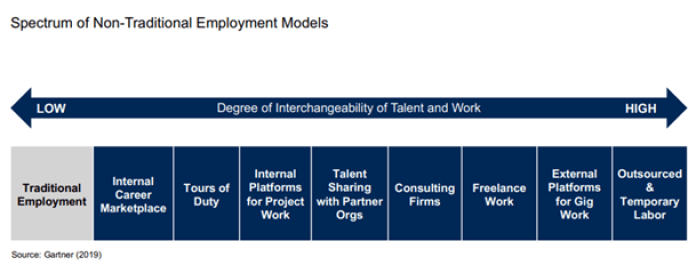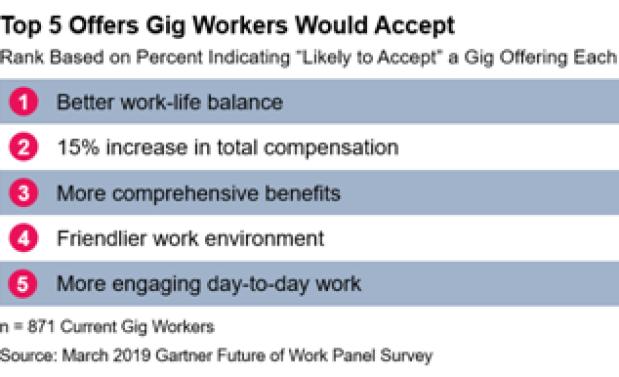
Thriving in the Gig Economy – The Next Normal
On March 11, 2020, the World Health Organization declared the novel coronavirus (COVID-19) a global pandemic. Across the world, this has resulted in ushering a ‘new normal’ – in the way we work and interact.
Remote working whether it is working from home (WFH) or working from anywhere (WFA) has become necessary and acceptable across industries, even in sectors where it was not earlier considered a possibility. Industries ranging from IT, e-commerce, and automotive are reimagining how this would affect their long-term people strategies.
Another area that has come to the forefront during the current economic times is the gig economy. The gig economy is a labor market characterized by temporary, flexible, and short-term jobs for which organizations hire independent workers on an on-demand basis. The terms ‘gig economy’ and ‘future of work’ are inextricably linked. Similar to how Japanese companies famously transformed supply chains with ‘just-in-time’ manufacturing and the dot – com revolution revolutionized the modern marketplace with e-commerce, the world of work is changing with the ‘just in time’ employment offered by a spectrum of non-traditional employment models, most notable of which is the gig economy.

Gig workers include self-employed, freelancers, independent contributors, and part-time workers. This project-based gig economy allows the service adopter to cut overhead costs, and the gig worker to get paid for a specific task performed instead of receiving a fixed salary. Thus, a shift from a full time 9-to-5 job to an on-demand, freelance, and task-based economy can be termed as the gig economy.
“Gig economy appears to provide a win-win to employers and employees. From an employer perspective, the gig economy allows organizations to better optimize work and manpower requirements. By mobilizing a larger workforce, organizations can also mitigate the anticipated talent crunch.”
For employees, gig economy allows task ownership, convenience, variety, and flexibility. Based on tastes and preferences, you can determine the number and type of projects you work on, the quantum of your earnings, and thus, the work-life balance. The below table illustrates the top 5 motivators for gig workers, notably better work-life balance ranks ahead of increased compensation.
[the_ad id=”1630″]

Although a large proportion of jobs in the ambit of the gig economy earlier came from ride-hailing and task-oriented services (allowing organizations to rapidly resolve large, voluminous, and tedious tasks by breaking it and crowdsourcing it to the gig economy), as per a recent report[1] by Mckinsey, knowledge-intensive and creative occupations are the fastest-growing segments in the world of independent work.
An examination of the gig economy in India presents itself as a microcosm of the above trend. In India, around 1.3 million people joined the gig economy in the second half of 2018-19and recorded 30% growth in the first half of the year. According to an Invest Indiareport [3], India has emerged as the 5th largest country for Flexi-staffing after US, China, Brazil and Japan. Haryana, Madhya Pradesh, Andhra Pradesh, Gujarat, and Telangana have most opportunities in terms of growth for the Flexi-workers. While the gig economy is popular amongst the blue-collar workers in India (particularly for companies such as Uber, Ola, Swiggy, Dunzo, etc.) there is now huge potential for the white-collar workers as well, due to increasing demand in industries – project-specific consultants, logo/content design, web design, instructional design etc.
Thriving in the Gig Economy
While gig workers enjoy a fair amount of flexibility, they also find themselves under the constant pressure to produce or perish in a continuous evaluation environment – wherein they must present a unique value proposition through their previous work in order to secure their next gig.
As per a study published in Harvard Business Review [2]the most successful independent workers create the following four connections to manage the unpredictability and subsequent emotional upheavals of their nature of work while simultaneously drawing from the independence and autonomy that they get from such work:
- Place: A dedicated place to work, with easy access to tools of work and free from distractions
- Routines: A fixed routine to enhance performance and focus
- People: A close network of peers, role models, supportive collaborators or contacts in similar fields, who may not always be able to offer specific work advice but nonetheless help the gig workers push through tough times and embolden them to undertake the risks that their work entails
- Purpose: A large number of gig workers in the study attributed their success to taking up and delivering projects that linked in some way to a broader purpose
For organizations, leveraging gig workers is an exercise within the broader scope of workforce planning and utilizing the available manpower models effectively. The main benefits of using gig workers are:
- Cost savings: Utilizing gig workers organizations can almost dynamically manage the demand-supply of manpower resulting in cost savings
- Speed and agility: The gig economy enables organizations to quickly fill talent gaps, to meet specific skill requirements as they arise
- A boost to innovation: Incorporating gig workers allow for an outside-in perspective and the flow of best practices and new knowledge
From Talent Management perspective, HR leaders can enhance the ‘gig worker experience’ to bolster the organization’s reputation and keep supply pipelines warm. To design and deliver an enhanced ‘Assignment Value Proposition’ (AVP) to gig employees, HR Leaders must consider ways to enhance the ‘assignment experience’. Below are some low-cost strategies, to enhance the gig worker experience throughout the gig work journey.
| Hiring and Onboarding | During the Assignment | Offboarding |
| Streamline hiring processes and onboardingManage Quality of SupplyShare how the company culture applies to gig workersEnsure basic benefits | Enable flexible hoursFacilitate remote connections with technologyClarify expectations and boundaries of work | Gather Gig worker experience data – “exit interview”Maintain a talent database |
Key Challenges
While the benefits appear attractive, it is also prudent to be cautious about this model. As Sarah Kessler notes in her book about the gig economy (Gigged) [4], presenting this model as a cynosure puts forward an incomplete picture. As she describes – “the gig economy can create opportunities for some people, but it can also amplify problems around insecurity, increased risk, lack of stability, and diminished worker rights.”Additionally, for managing the contingent workforce, many organizations have fragmented governance models, manual systems and processes, and insufficient talent analytics to fully utilize the potential of ‘on-demand’ talent. There are also challenges with respect to the information and data security, cybersecurity, and intellectual property.
Way Forward
In the Indian context, the gig economy offers tremendous scope for providing employment to a large population, the parameters of stability and security continue to be of paramount importance to the large proportion of our workforce. The labour ministry in India is currently working on a program that will offer minimum social security to gig economy workers and digital consumer platform partners. Benefits could include pension, provident fund contributions, health insurance and unemployment wages and more as part of the various government schemes.
The ongoing pandemic has accelerated the adaptation of work from anywhere and there is more openness towards the gig economy and contingent workers. It is important that organizations and governments prioritize the safety, security and basic rights of gig workers and put in place better talent analytics and management processes for contingent workers.
